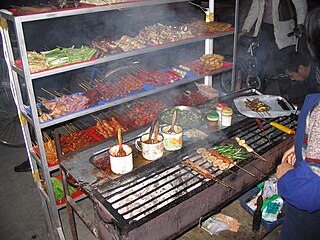
Chess is a recreational and competitive board game played between two players. It is sometimes called Western or international chess to distinguish it from related games such as xiangqi. The current form of the game emerged in Southern Europe during the second half of the 15th century after evolving from similar, much older games of Indian and Persian origin. Today, chess is one of the world's most popular games, played by millions of people worldwide at home, in clubs, online, by correspondence, and in tournaments.
Chess strategy is the aspect of chess play concerned with evaluation of chess positions and setting of goals and long-term plans for future play. While evaluating a position strategically, a player must take into account such factors as the relative value of the pieces on the board, pawn structure, king safety, position of pieces, and control of key squares and groups of squares. Chess strategy is distinguished from chess tactics, which is the aspect of play concerned with the move-by-move setting up of threats and defenses. Some authors distinguish static strategic imbalances, which tend to persist for many moves, from dynamic imbalances, which are temporary. This distinction affects the immediacy with which a sought-after plan should take effect. Until players reach the skill level of "master", chess tactics tend to ultimately decide the outcomes of games more often than strategy does. Many chess coaches thus emphasize the study of tactics as the most efficient way to improve one's results in serious chess play.

The bishop (♗,♝) is a piece in the game of chess. Each player begins the game with two bishops. One starts between the king's knight and the king, the other between the queen's knight and the queen. The starting squares are c1 and f1 for White's bishops, and c8 and f8 for Black's bishops.

In chess, a fork is a tactic whereby a single piece makes two or more direct attacks simultaneously. Most commonly two pieces are threatened, which is also sometimes called a double attack. The attacker usually aims to gain material by capturing one of the opponent's pieces. The defender often finds it difficult to counter two or more threats in a single move. The attacking piece is called the forking piece; the pieces attacked are said to be forked. A piece that is defended can still be said to be forked if the forking piece has a lower value.
In chess, a pin is a situation brought on by an attacking piece in which a defending piece cannot move without exposing a more valuable defending piece on its other side to capture by the attacking piece. Moving the attacking piece to bring on the pin is called pinning; the defending piece so restricted is described as pinned.

A skewer is a thin metal or wood stick used to hold pieces of food together. The word may sometimes be used as a metonym, to refer to the entire food item served on a skewer, as in "chicken skewers". Skewers are used while grilling or roasting meats and fish, and in other culinary applications.

Souvlaki, plural souvlakia, is a popular Greek fast food consisting of small pieces of meat and sometimes vegetables grilled on a skewer. It is usually eaten straight off the skewer while still hot. It can be served with pita bread, fried potatoes, lemon, and sauces, but the souvlaki itself is eaten on its own, with the side dishes eaten subsequently. The meat usually used in Greece and Cyprus is pork, although chicken, beef, and lamb may also be used. In other countries, souvlaki may be made with meats such as lamb, beef, chicken, and sometimes fish.
In chess, a combination is a sequence of moves, often initiated by a sacrifice, which leaves the opponent few options and results in tangible gain. At most points in a chess game, each player has several reasonable options from which to choose, which makes it difficult to plan ahead except in strategic terms. Combinations, in contrast to the norm, are sufficiently forcing that one can calculate exactly how advantage will be achieved against any defense. Indeed, it is usually necessary to see several moves ahead in exact detail before launching a combination, or else the initial sacrifice would not be undertaken.

Shashlik, or shashlyk, is a dish of skewered and grilled cubes of meat, similar to or synonymous with shish kebab. It is known traditionally, by various other names in the Caucasus and Central Asia, and from the 19th century became popular as shashlik across much of the Russian Empire.

Kebabs are various cooked meat dishes with their origins in Middle Eastern cuisine. Numerous variants are popular around the world.
The zwischenzug is a chess tactic in which a player, instead of playing the expected move, first interposes another move posing an immediate threat that the opponent must answer, and only then plays the expected move. It is a move that has a high degree of "initiative". Ideally, the zwischenzug changes the situation to the player's advantage, such as by gaining material or avoiding what would otherwise be a strong continuation for the opponent.
In chess, the term X-ray or X-ray attack is sometimes used as a synonym for skewer. It can also refer to a tactic where a piece either:
In chess, a tactic refers to a sequence of moves that limits the opponent's options and may result in tangible gain. Tactics are usually contrasted with strategy, in which advantages take longer to be realized, and the opponent is less constrained in responding.

A check is a condition in chess, shogi, xiangqi, and janggi that occurs when a player's king is under threat of capture on their opponent's next turn. A king so threatened is said to be in check. A player must get out of check, if possible, by interposing a piece between the threatening piece and the king, capturing the threatening piece, or moving the king to a square where it is no longer in check. If the player cannot move out of check, the game ends in checkmate and the player loses. Players cannot make any move that puts their own king in check.

Sosatie is a traditional South African dish of meat cooked on skewers. The term derives from sate and saus. It is of Cape Malay origin, used in Afrikaans, the primary language of the Cape Malays, and the word has gained greater circulation in South Africa. Marinated, cubed meat is skewered and cooked by braaing (barbecued) shish-kebab style. Sosatie recipes vary, but commonly the ingredients can include cubes of lamb, beef, chicken, dried apricots, red onions and mixed peppers.

Banana cue or bananacue is a popular snack food or street food in the Philippines. It is a portmanteau of banana and barbecue, which in Philippine English refers to meat cooked in a style similar to satay.

Yakitori is a Japanese type of skewered chicken. Its preparation involves skewering the meat with kushi (串), a type of skewer typically made of steel, bamboo, or similar materials. Afterwards, they are grilled over a charcoal fire. During or after cooking, the meat is typically seasoned with tare sauce or salt. The term is sometimes used informally for kushiyaki in general.
In chess, a skewer is an attack upon two pieces in a line and is similar to a pin. A skewer is sometimes described as a "reverse pin"; the difference is that in a skewer, the more valuable piece is the one under direct attack. The opponent is compelled to move the more valuable piece to avoid its capture, thereby exposing the less valuable piece which can then be captured. Only line pieces can skewer; kings, knights, and pawns cannot.

The following outline is provided as an overview of and topical guide to chess:

Shaokao, also romanized as shao kao, is the Chinese translation of "barbecue". Chinese variants of the practice constitute a significant aspect of Chinese cuisine. In China, it is predominantly found on busy Chinese streets and night markets as a street food sold in food stalls and is a type of xiaochi. In China and elsewhere, such as in the United States, diners sometimes also order beer as an accompaniment.











